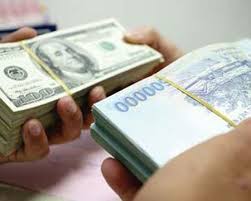
| SBV unexpectedly raises dollar prices, exporters leap for joy | |
The move by the State Bank of Vietnam of raising the dollar buy price has been commented as showing its determination to keep the dong/dollar exchange rate stable. On August 7, the State Bank Exchange unexpectedly raised the dollar buy price from VND20,826 to VND21,000 per dollar. In fact, the VND21,000 per dollar threshold was set up on the market a long time ago already. However, any move by the State Bank would have impacts on the market immediately. On the same day, commercial banks raised their buy prices after two days of reduction. Vietcombank and BIDV, for example, bought at VND21,040 per dollar, an increase of VND30 over August 6. Analysts have commented that the State Bank tries to buy more dollars not only in order to increase the foreign currency reserves, but also to stabilize the exchange rate. With the intervention by the central bank, the dollar price will not be decreasing further. In the past, the State Bank many times succeeded in stabilizing the exchange rate by applying the same measure. On April 29, it raised the buy price by VND214 per dollar from VND20,486 to VND20,700. Governor of the State Bank of Vietnam Nguyen Van Binh, when talking about the exchange rate policy for the remaining months of 2013, said the exchange rate would be regulated in a flexible way which aims to give strong support to the export. Farm produce exporters applaud dollar price hike Nguyen Hai Trieu, Director of Gio Moi Company, a shrimp exporter, said it is really the good news for farm produce exporters who get payment in dollars and then sell to banks. The company exports some $10 million worth of shrimp a year, which means that it would get VND2.74 billion more in turnover thanks to the dollar price increase. Especially, Trieu said, the higher earnings would help ease the burden on businesses caused by the petrol and electricity price increases. Truong Tuyet Phuong, Deputy General Director of Vinh Hoan, also a seafood company, also said the dollar price increase is big enough to bring VND40-50 billion more in turnover to the company. She went on to say that once exporters can make higher profits, they would be able to raise the prices of materials they buy from farmers, thus more benefiting farmers. However, the benefits farm produce exporters can enjoy would still depend on the production costs of enterprises and industries. Cashew nut exporters, for example, exported $700 million worth of products in the first half of the year, but did not get big benefits, because 50 percent of the materials were imports, for which they also paid in dollars. The same thing has been reported for garment and shoe makers. Le Dang Doanh, a well-known expert, also commented that the dollar price increase has really made exporters happy, especially those, who use domestically sourced materials. He also highly appreciated the central bank’s commitments to stabilize the exchange rate, because the stabilization would help businesses program their business plans and boost exports. How will be the exchange rate? Kim Eng Securities Company, in its report, said the foreign currency market has cooled after a tense period from June to mid July. It has predicted that the dollar price may increase by 2-3 percent this year as committed by the State Bank. Dr Le Tham Duong from the HCM City Banking University also thinks the State Bank would succeed in keeping the exchange rate stabilized as it stated earlier this year. | |
| vietnamnet |
